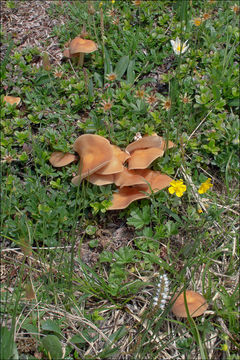Imagem de Gymnopus dryophilus (Bull.) Murrill 1916

Descrição:
Slo.: vitka korenovka - syn.: Collybia dryophila (Bull.: Fr.) Kumm., Collybia aquosa var. dryophila (Bull.: Fr.) Krieglsteiner - Habitat: alpine grassland, almost flat terrain, shallow calcareous skeletal ground with some silicate, relatively dry and warm place, full sun; exposed to direct rain; growing among Rhododendron hirsutum, Homogyne alpina, Antenaria carpatica, Dryas octopetala, Salix retusa, Helianthemum sp., Polygonum viviparum, Alchemilla sp., Potentilla crantzii, Trifolium montanum, Vaccinium vitis-idaea, Thymus serpyllum agg., Centraria islandica; average precipitations ~ 3.000 mm/year, average temperature 0-2 deg C, elevation 1.975 m (6.500 feet), alpine phytogeographical region. - Substratum: apparently soil and debris of Dryas octopetala roots and branches. - Comments: Gymnopus dryophilus is a saprophytic species. Standard books generally consider it growing in all kinds of woods under trees (Ref.:7 and elsewhere). Its Latin species name suggests the same - 'dryophilus' means 'oak loving'. Similarly does its German name - 'Waldfreund' means 'friend of woods'. It is most common in submontane elevations 400-600 m (Ref.: 6.). That is why I was initially reluctant regarding my determination of these fungi found in open stony grassland far of any trees in an alpine phytogeographical region at around 2.000 m (6.500 feet) elevation. Later I realized that the species has been found in similar habitats also at significantly higher elevations than this: in Stubaier Alps, Austria (Ref.: 2) and Italian West Alps (Ref.:5), in Switzerland (Ref. 3), in Pyrenees (Ref.:4) and elsewhere outside of its 'traditional' habitats, for example in glacier forefront in Scandinavia (Ref. 8). Apparently the species must have a very broad ecological range. - Growing mostly in groups of a few to several fruit bodies. Over 40 pilei were found in a plot of about 4 x 4 m. Pileus diameter 4(6) cm, stipe up to 8 cm long and up to 8 mm in diameter; taste and smell indistinctive, mild and mushroomy; SP white. - Spores smooth. Dimensions: 6.6 [7.1 ; 7.3] 7.8 x 3.2 [3.5 ; 3.7] 3.9 microns, Q = 1.8 [2] 2.2; N = 40; C = 95%, Me = 7.2 x 3.6 microns; Qe = 2. Olympus CH20, NEA 100x/1.25, magnification 1.000 x, oil (spores) and NEA 40x/0.65, magnification 400x, in water. AmScope MA500 digital camera. - Herbarium: Mycotheca and lichen herbarium (LJU-Li) of Slovenian Forestry Institute, Vena pot 2, Ljubljana, Index Herbariorum LJF - Ref.: (1) Personal communication with Mr. Gregor Podgornik, NAC Natural History Center, Tolmin, SI and Mr. Bojan Rot, www.gobenabovskem,si (2) H. Besl, Beitrge zur Kryptogamen flora im Gebiet der Neuen Regensburger Hutte (Stubaier Alpen, sterreich), Hoppea, Denkschr. Regensb. Bot. Ges., Vol.61 (2000), pp57-69 (3) B. Senn-Irlet, Macromycetes in alpine bed communities - mycocoenological investigations, Acta Bot. Neerl., Vol. 37(2) (1988), pp 251-263 (4) J. Vila, J. Llistosella, X. Llimona, Contribucio al Coneixement dels fongs de l'estatge Alpi dels Pirineus de Catalunya, Rev. Catal. Micol., Vol. 20. (1997), pp 221-232. (5) G.L. Bue, F. Montachhhini, A. Ceruti, Macromycetes of the alpine belt: Mycocoenological investigations in the Western Italian Alps by multivariate methods, Coenoses, Vol. 9(3). (1994), pp 103-153 (6) G.J. Krieglsteiner (Hrsg.), Die Grosspilze Baden-Wrttembergs, Band 3., Ulmer (2001), p 206. (7) D. Arora, Mushrooms Demystified, Ten Speed Press, Berkeley (1986), p 215. (8) G. Alfredsen, K. Hiland, Succession of terrestrial macrofungi along a deglaciation gradient at Glacier Blisen, South Norway, Nord. J. of Botany, Vol 21(1) (2001), pp 19-37 (9) R. Phillips, Mushrooms, Macmillan (2006), p 122. (10) S. Buczacki, Collins Fungi Guide, Collins (2012), p 174. (11) M. Bon, Parey's Buch der Pilze, Kosmos (2005), p 178.
Incluído nas seguintes páginas:
- Life
- Cellular
- Eukaryota (Eucariontes)
- Opisthokonta
- Nucletmycea
- Fungi
- Dikarya
- Basidiomycota
- Agaricomycetes
- Agaricales
- Omphalotaceae
- Gymnopus
- Gymnopus dryophilus
Esta imagem não aparece em nenhuma coleção.
Informação de origem
- licença
- cc-by-nc-sa-3.0
- direitos autorais
- 2014 Dr. Amadej Trnkoczy
- fotógrafo
- Dr. Amadej Trnkoczy
- original
- arquivo de mídia original
- visite a fonte
- site do parceiro
- CalPhotos
- ID


